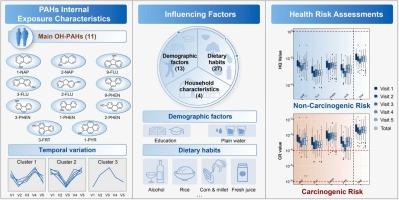中国BAPE研究中健康老年人尿中单羟基多环芳烃暴露特征、影响因素及健康风险
IF 11.3
1区 环境科学与生态学
Q1 ENGINEERING, ENVIRONMENTAL
引用次数: 0
摘要
通过部分燃烧碳基材料形成的多环芳烃(PAHs)是一类普遍存在的与重大人类健康风险相关的环境污染物。然而,仍然缺乏全面的接触和健康风险评估,特别是在老年人中。本研究对山东省济南市76名健康老年人进行了为期5个月的5次连续调查,以量化16种单羟基多环芳烃(OH-PAHs)的尿液浓度及其相关的健康风险。为了研究多环芳烃暴露的决定因素,我们使用了Spearman相关和线性混合效应建模技术。16种OH-PAHs中,1-羟基萘(1-NAP)尿中浓度峰值为1.78 μg/g肌酐。尿中OH-PAHs浓度受人口统计学因素和饮食习惯的显著影响。该参数与受教育程度和酒精摄入量呈负相关,而与饮用水、大米、小米、玉米制品和热加工油炸食品的摄入量呈正相关。危害指数(HI)分析显示,本研究中健康老年人接触多环芳烃没有潜在的非致癌风险。此外,致癌风险评估表明,所有参与者都超过了10-4的最高安全阈值,强调致癌性是主要的健康问题。本研究结果为制定有针对性的多环芳烃暴露缓解政策提供了关键的科学依据,特别是在饮食暴露途径方面。它们为公共卫生决策提供了新的见解,使饮食干预策略得以优化,以减少与老年人多环芳烃暴露相关的健康风险,从而有助于实现健康老龄化的目标。本文章由计算机程序翻译,如有差异,请以英文原文为准。

Urinary monohydroxylated polycyclic aromatic hydrocarbons among healthy elderly in the China BAPE Study: Exposure characteristics, influencing factors, and health risks
Formed through the partial burning of carbon-based materials, polycyclic aromatic hydrocarbons (PAHs) represent a prevalent class of environmental contaminants associated with significant human health risks. However, comprehensive exposure and health risk assessment remain lacked, specifically among the elderly population. This research involved carrying out five sequential surveys across a five-month period, with 76 healthy elderly individuals participating from Jinan, Shandong Province, to quantify urinary concentrations of 16 monohydroxylated PAHs (OH-PAHs) and their associated health risks. To investigate determinants of PAHs exposure, we utilized Spearman correlation and linear mixed-effects modeling techniques. Among the 16 OH-PAHs, 1-hydroxynaphthalene (1-NAP) demonstrated the peak median urinary concentration at 1.78 μg/g creatinine. Urinary OH-PAHs concentrations were significantly influenced by demographic factors and dietary habits. The parameter showed a negative association with educational level and alcohol intake, yet aligned positively with the consumption of drinking water, rice, millets, corn products, and thermally processed fried foods. Hazard index (HI) analysis showed that no potential non-carcinogenic risks from PAH exposures among healthy older adults in this study. Furthermore, carcinogenic risk assessment demonstrated that all participants exceeded the upper safety threshold of 10-4, highlighting carcinogenicity as the predominant health concern. The findings of this study provide key scientific evidence for formulating targeted PAHs exposure mitigation policies, especially in the dietary exposure route. They provide novel insights to inform public health decision-making, enabling the optimization of dietary intervention strategies to reduce health risks associated with PAHs exposure among the elderly population, thereby contributing to the goal of healthy aging.
求助全文
通过发布文献求助,成功后即可免费获取论文全文。
去求助
来源期刊

Journal of Hazardous Materials
工程技术-工程:环境
CiteScore
25.40
自引率
5.90%
发文量
3059
审稿时长
58 days
期刊介绍:
The Journal of Hazardous Materials serves as a global platform for promoting cutting-edge research in the field of Environmental Science and Engineering. Our publication features a wide range of articles, including full-length research papers, review articles, and perspectives, with the aim of enhancing our understanding of the dangers and risks associated with various materials concerning public health and the environment. It is important to note that the term "environmental contaminants" refers specifically to substances that pose hazardous effects through contamination, while excluding those that do not have such impacts on the environment or human health. Moreover, we emphasize the distinction between wastes and hazardous materials in order to provide further clarity on the scope of the journal. We have a keen interest in exploring specific compounds and microbial agents that have adverse effects on the environment.
 求助内容:
求助内容: 应助结果提醒方式:
应助结果提醒方式:


